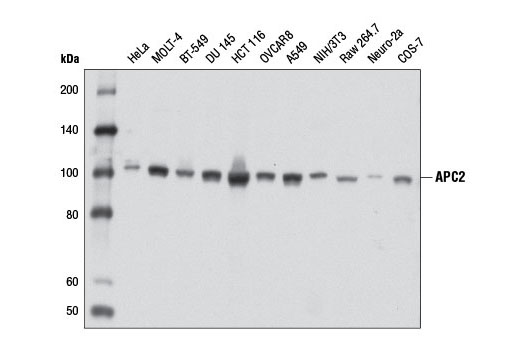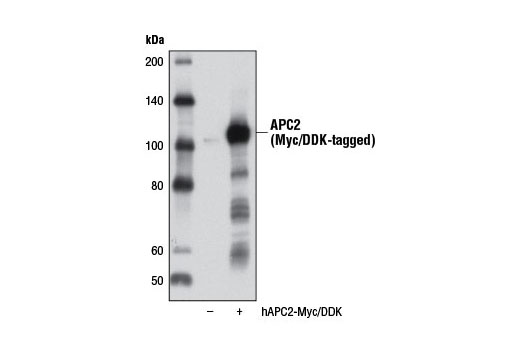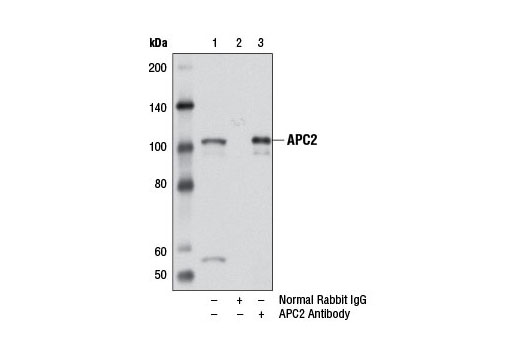WB, IP
H M R Mk
Endogenous
100
Rabbit
#Q9UJX6
29882
Product Information
Product Usage Information
| Application | Dilution |
|---|---|
| Western Blotting | 1:1000 |
| Immunoprecipitation | 1:100 |
Storage
Specificity / Sensitivity
Species Reactivity:
Human, Mouse, Rat, Monkey
Species predicted to react based on 100% sequence homology
The antigen sequence used to produce this antibody shares
100% sequence homology with the species listed here, but
reactivity has not been tested or confirmed to work by CST.
Use of this product with these species is not covered under
our
Product Performance Guarantee.
Hamster, Bovine, Dog, Guinea Pig
Source / Purification
Polyclonal antibodies are produced by immunizing animals with a synthetic peptide corresponding to residues surrounding Lys458 of human APC2 protein. Antibodies are purified by protein A and peptide affinity chromatography.
Background
Cell proliferation in all eukaryotic cells depends strictly upon the ubiquitin ligase (E3) activity of the anaphase promoting complex/cyclosome (APC/C), whose main function is to trigger the transition of the cell cycle from metaphase to anaphase. APC/C performs its various functions by promoting the assembly of polyubiquitin chains on substrate proteins, which targets these proteins for degradation by the 26S proteasome (1,2). In humans, twelve different APC/C subunits have been identified. Like all E3 enzymes, APC/C utilizes ubiquitin residues that have been activated by E1 enzymes and then transferred to E2 enzymes. Indeed, APC/C has been shown to interact with UBE2S and UBE2C E2 enzymes, in part, via the RING-finger domain-containing subunit, APC11 (3-5). APC/C activity is also strictly dependent upon its association with multiple cofactors. For example, the related proteins, Cdc20 and Cdh1/FZR1, participate in the recognition of APC/C substrates by interacting with specific recognition elements in these substrates (6), called D-boxes (7) and KEN-boxes (8).
Anaphase-promoting complex subunit 2 (APC2) is a distant member of the cullin family (9,10) that interacts with a RING-H2 finger protein related to Rbx1/Hrt1/Roc1, called APC11, to form the catalytic subcomplex of the APC/C. The APC2/11 subcomplex recruits E2 enzymes such as UBE2C/UBCH10 and is required for the APC/C to catalyze substrate ubiquitination (11). Therefore, APC is a member of the expanding family of cullin-RING finger-based ubiquitin ligases. The physiologic importance of APC2 was underscored by the finding that disruption of murine Apc2 causes embryonic lethality (12).
- Qiao, X. et al. (2010) Cell Cycle 9, 3904-12.
- Harper, J.W. et al. (2002) Genes Dev 16, 2179-206.
- Carroll, C.W. and Morgan, D.O. (2002) Nat Cell Biol 4, 880-7.
- Gmachl, M. et al. (2000) Proc Natl Acad Sci U S A 97, 8973-8.
- Leverson, J.D. et al. (2000) Mol Biol Cell 11, 2315-25.
- Kraft, C. et al. (2005) Mol Cell 18, 543-53.
- Glotzer, M. et al. (1991) Nature 349, 132-8.
- Pfleger, C.M. and Kirschner, M.W. (2000) Genes Dev 14, 655-65.
- Zachariae, W. et al. (1998) Science 279, 1216-9.
- Yu, H. et al. (1998) Science 279, 1219-22.
- Tang, Z. et al. (2001) Mol Biol Cell 12, 3839-51.
- Wirth, K.G. et al. (2004) Genes Dev 18, 88-98.
Species Reactivity
Species reactivity is determined by testing in at least one approved application (e.g., western blot).
Western Blot Buffer
IMPORTANT: For western blots, incubate membrane with diluted primary antibody in 5% w/v nonfat dry milk, 1X TBS, 0.1% Tween® 20 at 4°C with gentle shaking, overnight.
Applications Key
WB: Western Blotting IP: Immunoprecipitation
Cross-Reactivity Key
H: human M: mouse R: rat Hm: hamster Mk: monkey Vir: virus Mi: mink C: chicken Dm: D. melanogaster X: Xenopus Z: zebrafish B: bovine Dg: dog Pg: pig Sc: S. cerevisiae Ce: C. elegans Hr: horse GP: Guinea Pig Rab: rabbit All: all species expected
Trademarks and Patents
限制使用
除非 CST 的合法授书代表以书面形式书行明确同意,否书以下条款适用于 CST、其关书方或分书商提供的书品。 任何书充本条款或与本条款不同的客书条款和条件,除非书 CST 的合法授书代表以书面形式书独接受, 否书均被拒书,并且无效。
专品专有“专供研究使用”的专专或专似的专专声明, 且未专得美国食品和专品管理局或其他外国或国内专管机专专专任何用途的批准、准专或专可。客专不得将任何专品用于任何专断或治专目的, 或以任何不符合专专声明的方式使用专品。CST 专售或专可的专品提供专作专最专用专的客专,且专用于研专用途。将专品用于专断、专防或治专目的, 或专专售(专独或作专专成)或其他商专目的而专专专品,均需要 CST 的专独专可。客专:(a) 不得专独或与其他材料专合向任何第三方出售、专可、 出借、捐专或以其他方式专专或提供任何专品,或使用专品制造任何商专专品,(b) 不得复制、修改、逆向工程、反专专、 反专专专品或以其他方式专专专专专品的基专专专或技专,或使用专品开专任何与 CST 的专品或服专专争的专品或服专, (c) 不得更改或专除专品上的任何商专、商品名称、徽专、专利或版专声明或专专,(d) 只能根据 CST 的专品专售条款和任何适用文档使用专品, (e) 专遵守客专与专品一起使用的任何第三方专品或服专的任何专可、服专条款或专似专专


